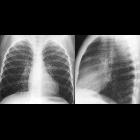Beckwith-Wiedemann syndrome

Beckwith-Wiedemann
syndrome • Beckwith-Wiedemann syndrome - Ganzer Fall bei Radiopaedia

Beckwith-Wiedemann
syndrome • Beckwith-Wiedemann syndrome - Ganzer Fall bei Radiopaedia

Beckwith-Wiedemann
syndrome • Beckwith-Wiedemann syndrome - Ganzer Fall bei Radiopaedia

Beckwith-Wiedemann
syndrome • Beckwith-Wiedeman syndrome with bilateral Wilms tumors - Ganzer Fall bei Radiopaedia
Beckwith-Wiedemann syndrome (BWS) is a congenital overgrowth disorder characterized by a unique set of features that can consist of:
- macroglossia: most common clinical finding
- otic dysplasia
- omphalocoele
- localized gigantism / macrosomia
- hemihypertrophy
- cardiac anomalies
- pancreatic islet cell hyperplasia
- organomegaly
- nephromegaly
- hepatosplenomegaly
Epidemiology
The incidence is reported at ~1:13,000-37,000 live births.
Pathology
The majority of cases are sporadic while a small proportion (~15%) is autosomal dominant with abnormality related to chromosome 11p15.5. The syndrome carries a well recognized increased risk for the development of neoplasia . Another 10-20 of cases show paternal disomy 11.
Associations
- Wilms tumor(s)
- polyhydramnios
- non-malignant renal diseases
- medullary renal cysts
- calyceal diverticula
- nephrolithiasis
- premalignant renal diseases
- perilobar nephroblastomatosis
- adrenocortical carcinoma
- gonadoblastoma
- rhabdomyosarcoma
- neuroblastoma
- pancreatoblastoma
- hepatoblastoma
- placental pathology
- postnatal hypoglycemia
- genitourinary anomalies
History and etymology
First described independently by JB Beckwith in 1963 and H-R Wiedemann in 1964 .
Siehe auch:
- Nierensteine
- Neuroblastom
- Rhabdomyosarkom
- Kryptorchismus
- Hepatoblastom
- Polyhydramnion
- Nebennierenrindenkarzinom
- hepatosplenomegaly
- Nephroblastom
- Proteus-Syndrom
- Omphalozele
- Hypospadie
- Klippel-Trénaunay-Weber-Syndrom
- Neurofibromatose
- Pankreatoblastom
- PTEN-Hamartom-Tumor-Syndrom
- Perlman-Syndrom
- Simpson-Golabi-Behmel-Syndrom
- molar degeneration of placenta
- Makrosomie
- Haberland-Syndrom
- Makroglossie
- Kelchdivertikel
- lokaler Gigantismus
- Plazentamegalie
- Nephromegalie
- Organomegaly
- Megalenzephalie-Kapillarfehlbildungen-Polymikrogyrie-Syndrom
- cardiac anomalies
- otic dysplasia
- perilobar nephroblastomatosis
- pancreatic islet cell hyperplasia
und weiter:
- Milzhämangiom
- Ollier-Syndrom
- angeborene renale Anomalien
- macrodystrophia lipomatosa
- fetal hepatomegaly
- Nephroblastomatose
- hydropic degeneration of the placenta
- placental thickness
- ARPKD
- beschleunigte Skelettreifung
- enlarged echogenic fetal kidneys
- fetal hepatosplenomegaly
- Hemihyperplasie
- Megalencephaly-capillary malformation syndrome
- Megaloenzephalie
- limb hypertrophy
- Weaver-Syndrom

 Assoziationen und Differentialdiagnosen zu Beckwith-Wiedemann-Syndrom:
Assoziationen und Differentialdiagnosen zu Beckwith-Wiedemann-Syndrom:















